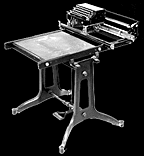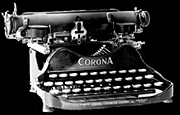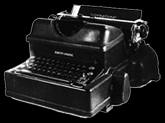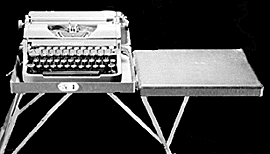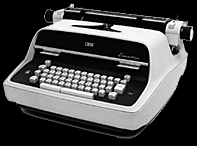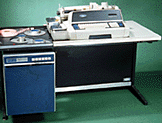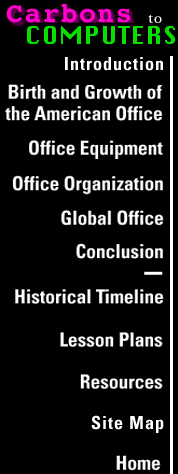
The Typewriter 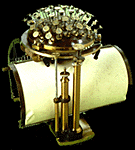
Living when people can "process words," instantly copy them, and even send them almost anywhere in the world over the telephone lines, we may find it hard to believe that the forerunner of the word processor, the typewriter, was invented little more than a hundred years ago.
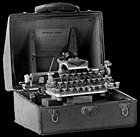 This once-ubiquitous part of the American
office, school, and home den followed a long road to recognition. The typewriter
found acceptance only when its promoters finally realized who would be its
most likely user. Before that could occur, however, social values that governed
personal and professional correspondence had to change to admit the use
of a mechanical device in place of the pen.
This once-ubiquitous part of the American
office, school, and home den followed a long road to recognition. The typewriter
found acceptance only when its promoters finally realized who would be its
most likely user. Before that could occur, however, social values that governed
personal and professional correspondence had to change to admit the use
of a mechanical device in place of the pen.
Technology and the Invention of the Typewriter
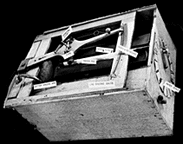 Practical writing machines became technologically feasible as early
as the fourteenth century. The invention of at least 112 such machines preceded
the successful Remington typewriter. Many of the early designs received
patents, and several were marketed on a limited basis. The first such patent
was issued to Henry Mill, an English engineer, in 1714. The first primitive
American machine was patented in 1829 by William Burt of Detroit.
Then in
Practical writing machines became technologically feasible as early
as the fourteenth century. The invention of at least 112 such machines preceded
the successful Remington typewriter. Many of the early designs received
patents, and several were marketed on a limited basis. The first such patent
was issued to Henry Mill, an English engineer, in 1714. The first primitive
American machine was patented in 1829 by William Burt of Detroit.
Then in 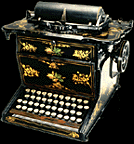 1868, American inventor Christopher Latham
Sholes developed the machine that finally succeeded on the market as the
Remington and established the modern idea of the typewriter. Sholes's first
try at a typewriting machine was a crude piece of work made with part of
an old table, a circular piece of glass, a telegraph key, a piece of carbon
paper, and piano wire. This led to an improved prototype resembling a toy
piano in appearance, which is now in the Smithsonian's National Museum of
American History.
1868, American inventor Christopher Latham
Sholes developed the machine that finally succeeded on the market as the
Remington and established the modern idea of the typewriter. Sholes's first
try at a typewriting machine was a crude piece of work made with part of
an old table, a circular piece of glass, a telegraph key, a piece of carbon
paper, and piano wire. This led to an improved prototype resembling a toy
piano in appearance, which is now in the Smithsonian's National Museum of
American History.
Despite the importance of Sholes's improvements in the
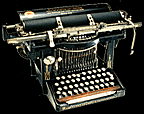 machine's mechanical workings over the next several
years, the story of the typewriter from 1868 to its booming success in the
late 1880s is really the story of its staunchest supporter, James Densmore.
Under Densmore's prodding, Sholes improved the first crude machine many
times over. Densmore was also responsible for recruiting the machine's first
mass manufacturer, E. Remington and Sons, of Ilion, New York, a company
that had made armaments during the Civil War and was looking for new products
to manufacture.
machine's mechanical workings over the next several
years, the story of the typewriter from 1868 to its booming success in the
late 1880s is really the story of its staunchest supporter, James Densmore.
Under Densmore's prodding, Sholes improved the first crude machine many
times over. Densmore was also responsible for recruiting the machine's first
mass manufacturer, E. Remington and Sons, of Ilion, New York, a company
that had made armaments during the Civil War and was looking for new products
to manufacture.
Finding a Market
The early typewriter's greatest problem was in finding
a market. No one knew who would want to buy a 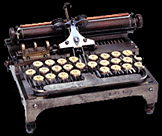 typewriter. Sholes thought his most likely customers
would be clergymen and men of letters and hoped that interest might then
expand to the general public. Neither he nor Densmore saw the obvious utility
of the typewriter in business. Sluggish economic conditions in the 1870s
were partly responsible for this lack of marketing foresight. Imperfections
in the typewriter itself may take another part of the blame. And, as hard
as it is to conceive of today, Americans in the 1870s and 1880s were deeply
uncomfortable with the strange notion of "mechanical writing."
Convention
typewriter. Sholes thought his most likely customers
would be clergymen and men of letters and hoped that interest might then
expand to the general public. Neither he nor Densmore saw the obvious utility
of the typewriter in business. Sluggish economic conditions in the 1870s
were partly responsible for this lack of marketing foresight. Imperfections
in the typewriter itself may take another part of the blame. And, as hard
as it is to conceive of today, Americans in the 1870s and 1880s were deeply
uncomfortable with the strange notion of "mechanical writing."
Convention 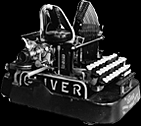 prescribed that all letters be written out in neat
longhand, and businessmen enjoyed no exception from this requirement.
prescribed that all letters be written out in neat
longhand, and businessmen enjoyed no exception from this requirement.
The nineteenth-century response to a typewritten letter
could have been something like our response to "junk mail"! In
addition, typed signatures could be forged. Some accounts tell of recipients
who were angered and insulted by typed letters, seeing them as a comment
on their inability to read handwriting.
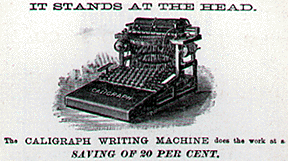
A marketing breakthrough finally occurred with the development of the concept of "scientific management" in the 1880s. With the specialization of work--some people doing correspondence, others keeping accounts, etc.--the typewriter at last found acceptance. People were ready to give up the old idea of business letters being governed by the same rules as personal letters when business became so big and impersonal that the change was possible.
The Changing Look of the Typewriter
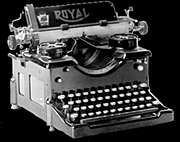 The changing look of the typewriter offers vivid
proof that the design of a manufactured object reflects a complex combination
of social values, economic needs, and profit-driven motives. Most office
equipment before 1940 was overtly mechanical and industrial in appearance.
In the difficult economic times of the world depression of the late 1920s
and the 1930s, offices had no trouble attracting workers, who would work
anywhere, under almost any conditions, and with any equipment. The first
changes in typewriter styling actually appeared not in office machines,
but in portables, which from the early 1930s were streamlined and offered
in color to encourage their use at home.
The changing look of the typewriter offers vivid
proof that the design of a manufactured object reflects a complex combination
of social values, economic needs, and profit-driven motives. Most office
equipment before 1940 was overtly mechanical and industrial in appearance.
In the difficult economic times of the world depression of the late 1920s
and the 1930s, offices had no trouble attracting workers, who would work
anywhere, under almost any conditions, and with any equipment. The first
changes in typewriter styling actually appeared not in office machines,
but in portables, which from the early 1930s were streamlined and offered
in color to encourage their use at home.
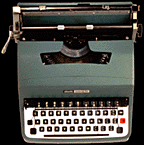 During the 1950s and 1960s, the entire environment
of the office changed along with most office equipment. From about 1950,
almost all office typewriter manufacturers presented their machines in colored
steel cases that concealed the mechanism and suggested a certain elegance.
If secretaries and typists were supposed to be above manual workers, it
was important that typewriters not look like machines but convey a
During the 1950s and 1960s, the entire environment
of the office changed along with most office equipment. From about 1950,
almost all office typewriter manufacturers presented their machines in colored
steel cases that concealed the mechanism and suggested a certain elegance.
If secretaries and typists were supposed to be above manual workers, it
was important that typewriters not look like machines but convey a 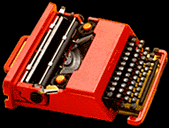 more respectable and less oppressive
image.
more respectable and less oppressive
image.
The electric typewriter helped advance this new image. Although the first electrics were produced in the 1930s, they did not gain wide acceptance until the 1950s.
When Is a Machine Obsolete?
In the 1970s the typewriter had to compete with t
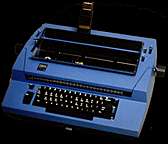 he word processor, a clever combination of the
typewriter keyboard with the brain of the computer. Word processing let
typists make mistakes, correct them, move things around, and change their
mind in ways that would require endless retyping on a conventional typewriter.
By the 1990s word processing became just another program (software) in personal
computers.
he word processor, a clever combination of the
typewriter keyboard with the brain of the computer. Word processing let
typists make mistakes, correct them, move things around, and change their
mind in ways that would require endless retyping on a conventional typewriter.
By the 1990s word processing became just another program (software) in personal
computers.
Yet typewriters still have a place in most homes and offices.
Office workers find typewriters faster for typing 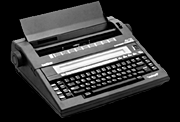 envelopes and other short jobs. It may be that
in ten or twenty years the typewriter will seem quaint and old-fashioned,
as carbon paper does today. But many people are quite attached to their
typewriters, some even stubbornly holding on to manual machines with the
same dedication seen in fountain pen users in this day of the felt tip pen!
envelopes and other short jobs. It may be that
in ten or twenty years the typewriter will seem quaint and old-fashioned,
as carbon paper does today. But many people are quite attached to their
typewriters, some even stubbornly holding on to manual machines with the
same dedication seen in fountain pen users in this day of the felt tip pen!
More images of typewriters:
